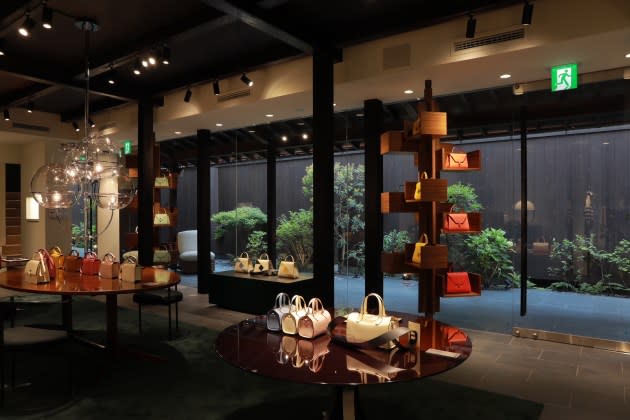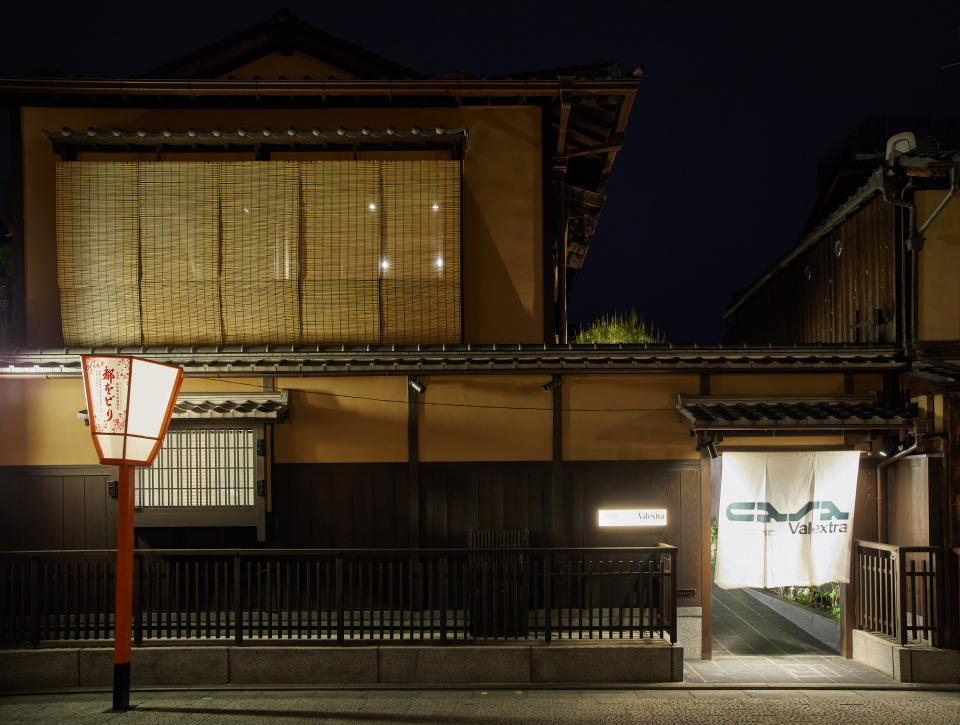Casa Valextra Concept Introduced in Kyoto

MILAN — Valextra is launching an experiential store concept and introducing product categories.
The storied Milan-based accessories company unveiled Casa Valextra in Kyoto, Japan, on Tuesday, which presents midcentury Italian design pieces along with art and craftsmanship from the city, once the capital of Japan.
More from WWD
Casa Valextra is located in a former two-story tea house on Hanami Street in the center of Gion, Kyoto.
Signature pieces by B.B.P.R., the architectural partnership founded in Milan in 1932; Gianfranco Frattini; Franco Albini; Gabriella Crespi and Luigi Caccia Dominioni — sourced from the private vintage collection of the Galleria Luisa Delle Piane in Milan — are displayed with traditional Japanese wood and stone structures.
On this occasion, Valextra is introducing a lifestyle category crafted in the brand’s signature Millepunte calf skin and completed by its black lacquered Costa edging and handpainted Inchiostro lines. It comprises a desk pad, pocket emptier, pen tray, agenda cover, jewelry box and a pencil case with Faber Castell pencils.
“The innovative format corresponds to a first attempt to create a more lifestyle experience for the brand and expand into other categories relevant with our brand equity such as gifting and home and travel,” said Xavier Rougeaux, chief executive officer of Valextra.
The store also carries original vintage Valextra signature pieces, from the 1963 Carita shoulder bag and the 1968 Tric Trac to the 1973 Premiere briefcase. In addition, limited editions of the brand’s leather goods were crafted exclusively as a tribute to the city of Kyoto, including the Costa travel case specifically engineered to hold a kimono, a silk foulard and an Iside handbag comprising a sculptural top handle.
“Casa Valextra crystalizes our passion for excellence, our engineering beauty and Milanese heritage while always making sure we create a conversation with the local culture and environment in an innovative way,” Rougeaux said. Valextra is known for its hand-crafted bags and leather goods marked by a signature lacquered piping.

On the second floor, there is a private bar space in collaboration with the Ritz Carlton Kyoto that serves classic Italian beverages, as well as a private salon for made-to-order service.
Casa Valextra was curated by Luciano Giorgi Studio LGB. The space’s custom-design brass and green-lacquered mirrored furnishings and green upholstery incorporate brushed and dyed hemlock wood in tribute to Japanese dark woods.
The space is complemented by a new typeface conceived by Studio Temp inspired by the 1962 Valextra typeface created by architect and graphic designer AG Fronzoni; Milanese design, including the 1964 M1 metro line handrail engineered by Bob Noorda and Franco Albini, and the 1957 Torre Velasca landmark engineered by B.B.P.R.

Rougeaux, previously CEO of Smythson in London, was named to his current role in 2021, succeeding Sara Ferrero. Concurrently, former Karl Lagerfeld and Chloé executive Ralph Toledano joined Valextra’s board of directors. Toledano is a partner in Neo Investment Partners, which bought a majority stake in Valextra in 2013. The London-based investment firm has stakes in fashion and lifestyle brands including Victoria Beckham Ltd., Miller Harris and Alain Mikli.
A Kyoto table designed in 1974 by Frattini for Pierluigi Ghianda, now reissued by Poltrona Frau, is a central piece at Casa Valextra due to its interlocking techniques that are a tribute to the architecture of the city.
Entering the garden under the deep sloping roof, a bamboo pouf and a small armchair by Gabriella Crespi from 1972 are positioned, together with a rattan structure finely folded by hand and featuring a Dedar fabric cover.
Beyond two Albero bookcases by Frattini designed in the late ’50s in Canaletto walnut wood there is a TL22 table designed by Franco Albini and produced by Poggi in the late ’50s in veneered wood with Indian rosewood edges. Among other key pieces, the chairs around the table are the Catilinas, designed by Caccia Dominioni in 1958 for Azucena, conceived to be a “domestic throne” inspired by Ancient Rome. Above hangs the Lyndon chandelier designed by Vico Magistretti in 1977 for Oluce.
Best of WWD


